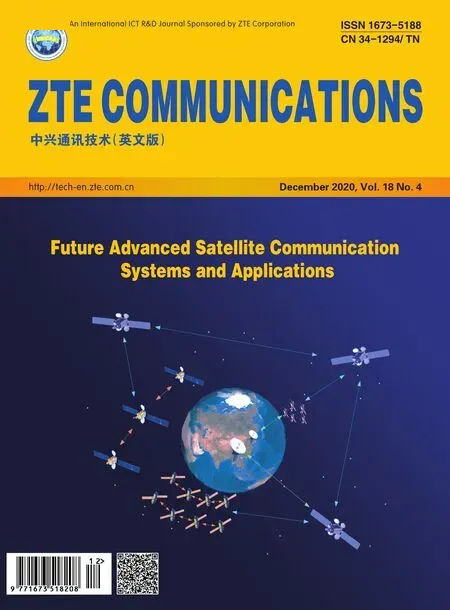Editorial:Special Topic on Future Advanced Satellite Communication Systems and Applications
In 2020,the world has faced unprecedented challenges in human history with the Covid-19 pandemic,but communication systems and technologies have helped tremendously for teleworking and teleconferences.The progress of new technologies,particularly for satellite communication systems and applications,is facilitating the global coverage.The significant development of satellite communications has been made in the recent years,including high throughput satellites(HTS),large-scale low earth orbit (LEO) satellite constellations with more than thousands of,even tens thousands of,satellites in each constellation,as well as medium earth orbit(MEO) constellations.Integration between satellite and terrestrial networks has been considered as an important part of the development of 5G mobile communication systems,but challenges remain on delivering 5G application scenarios over satellites for enhanced Mobile Broadband (eMBB),massive Machine Type Communications (mMTC) and Ultra Reliable Low Latency Communications (URLLC).Applications have also been developed to exploit the benefit of the global coverage of satellites and enable integration of communication systems with position and navigation services to serve the remote areas where it is impossible or not economical to reach by traditional terrestrial communication networks.
It has been recognised by the international communities and international standardisation bodies including ITU,ETSI and 3GPP that satellites will play an important role in the future global information infrastructure (GII).The emerging 6G systems are considered as the main part of future communications and network architecture.Research has been carried out in these areas and related standards have been under development.Satellite communications have become a hot topic of research and development and many related articles have been published in various international conferences,journals,magazines and newspapers.Therefore,it is timely for this journal to recognise these new developments and publish the latest results in the subject areas.We have carefully selected eight peer-reviewed papers to publish in this issue,covering the topics in the space-and-terrestrial integration for IoT,resource allocation strategy for satellite networks,security for spacebased network,slicing technique for satellite network,IP routing for LEO networks,space laser communications,satellite trajectory prediction,and medium access control (MAC) protocol for satellite access.
In the first paper“Space-Terrestrial Integrated Architecture for Internet of Things”,a method for space-terrestrial based IoT (ST-IoT) system is proposed.A reliable identification procedure,an integrated access and communication procedure and a clustering cooperative transmission strategy are also discussed.
The second paper“Resource Allocation Strategy Based on Matching Game”presents a new resource allocation scheme based on the many-to-many matching game scheme to improve the resource utilization efficiency and quality of experience(QoE).
The third paper“DDoS Attack Detection Method for Space-Based Network Based on SDN Architecture”introduces a method to prevent distributed denial of service (DDoS) attacks for space-based networks based on SDN architecture.Machine learning algorithms are used to reduce the DDoS detection time.
In the fourth paper“Satellite E2E Network Slicing Based on 5G Technology”,a novel scheme is proposed for satellite end-to-end (E2E) network slicing based on 5G technology to support flexible network deployment between satellite and ground segments.
The fifth paper“Adaptability Analysis of IP Routing Protocol in Broadband LEO Constellation Systems”provides evaluations of IP protocols on efficiency and reliability of various network services based on the two LEO constellation systems developed in China.
The sixth paper“Advanced Space Laser Communication Technology on CubeSats”reviews the state-of-the-art laser technologies and current progress on the CubeSats,and highlights the characteristics of laser link on the CubeSat and the key techniques for laser communication terminals (LCT) and related design.
The seventh paper“Feasibility Study of Decision Making for Terminal Switching Time of LEO Satellite Constellation Based on the SGP4 Model”presents an LEO satellite trajectory prediction model based on the terminal handover technique.The related validation was made using the measurement data from operational satellites.
Finally,an MAC layer random access scheme is proposed in the eighth paper“M-IRSA:Multi-Packets Transmitted Irregular Repetition Slotted Aloha”,allowing transmission of multiple packets per user with pre-coding procedure.
Overall,a good range of papers are presented to you.We look forward to the future development of satellite communication systems and applications and hope you all enjoy this special issue.
- ZTE Communications的其它文章
- Balanced Discriminative Transfer Feature Learning for Visual Domain Adaptation
- Robust Lane Detection and Tracking Based on Machine Vision
- M?IRSA:Multi?Packets Transmitted Irregular Repetition Slotted Aloha
- Feasibility Study of Decision Making for Terminal Switching Time of LEO Satellite Constellation Based on the SGP4 Model
- Advanced Space Laser Communication Technology on CubeSats
- Adaptability Analysis of IP Routing Protocol in Broadband LEO Constellation Systems

